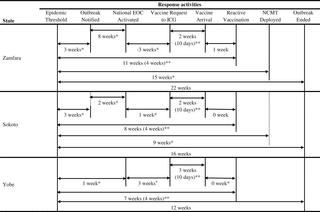PLOS ONE ( IF 3.7 ) Pub Date : 2018-06-19 , DOI: 10.1371/journal.pone.0199257 Assad Hassan 1, 2 , G U Mustapha 1, 2 , Bola B Lawal 1 , Aliyu M Na'uzo 1 , Raji Ismail 1 , Eteng Womi-Eteng Oboma 2 , Oyeronke Oyebanji 2 , Jeremiah Agenyi 2 , Chima Thomas 3 , Muhammad Shakir Balogun 1 , Mahmood M Dalhat 1 , Patrick Nguku 1 , Chikwe Ihekweazu 2

|
Background
Nigeria reports high rates of mortality linked with recurring meningococcal meningitis outbreaks within the African meningitis belt. Few studies have thoroughly described the response to these outbreaks to provide strong and actionable public health messages. We describe how time delays affected the response to the 2016/2017 meningococcal meningitis outbreak in Nigeria.
Methods
Using data from Nigeria Centre for Disease Control (NCDC), National Primary Health Care Development Agency (NPHCDA), World Health Organisation (WHO), and situation reports of rapid response teams, we calculated attack and death rates of reported suspected meningococcal meningitis cases per week in Zamfara, Sokoto and Yobe states respectively, between epidemiological week 49 in 2016 and epidemiological week 25 in 2017. We identified when alert and epidemic thresholds were crossed and determined when the outbreak was detected and notified in each state. We examined response activities to the outbreak.
Results
There were 12,535 suspected meningococcal meningitis cases and 877 deaths (CFR: 7.0%) in the three states. It took an average time of three weeks before the outbreaks were detected and notified to NCDC. Four weeks after receiving notification, an integrated response coordinating centre was set up by NCDC and requests for vaccines were sent to International Coordinating Group (ICG) on vaccine provision. While it took ICG one week to approve the requests, it took an average of two weeks for approximately 41% of requested vaccines to arrive. On the average, it took nine weeks from the date the epidemic threshold was crossed to commencement of reactive vaccination in the three states.
Conclusion
There were delays in detection and notification of the outbreak, in coordinating response activities, in requesting for vaccines and their arrival from ICG, and in initiating reactive vaccination. Reducing these delays in future outbreaks could help decrease the morbidity and mortality linked with meningococcal meningitis outbreaks.
中文翻译:

2017 年尼日利亚脑膜炎奈瑟菌血清群 C 暴发的响应时间延迟
背景
尼日利亚报告了与非洲脑膜炎带内反复爆发的脑膜炎球菌性脑膜炎有关的高死亡率。很少有研究彻底描述了对这些疫情的反应,以提供强有力和可操作的公共卫生信息。我们描述了时间延迟如何影响对尼日利亚 2016/2017 年脑膜炎球菌脑膜炎爆发的反应。
方法
利用尼日利亚疾病控制中心 (NCDC)、国家初级卫生保健发展署 (NPHCDA)、世界卫生组织 (WHO) 的数据和快速反应小组的情况报告,我们计算了每个报告的疑似脑膜炎球菌性脑膜炎病例的发病率和死亡率。在 2016 年第 49 周流行病学周和 2017 年第 25 周流行病学周期间,分别在 Zamfara、Sokoto 和 Yobe 州进行了一周。我们确定了何时跨越警报和流行病阈值,并确定了在每个州检测和通知爆发的时间。我们检查了对疫情的应对活动。
结果
这三个州共有 12,535 例疑似脑膜炎球菌性脑膜炎病例和 877 例死亡(病死率:7.0%)。在发现疫情并通知 NCDC 之前,平均需要三周的时间。收到通知四周后,NCDC 成立了一个综合应对协调中心,并将疫苗申请发送至国际协调小组 (ICG),以提供疫苗。虽然 ICG 花了一周时间批准这些申请,但平均需要两周时间才能收到大约 41% 的申请疫苗。平均而言,从跨越流行阈值之日到三个州开始反应性疫苗接种需要九周时间。
结论
在发现和通报疫情、协调应对活动、向 ICG 申请疫苗和送达疫苗以及启动反应性疫苗接种方面存在延误。减少未来爆发的这些延迟可能有助于降低与脑膜炎球菌性脑膜炎爆发相关的发病率和死亡率。



























 京公网安备 11010802027423号
京公网安备 11010802027423号